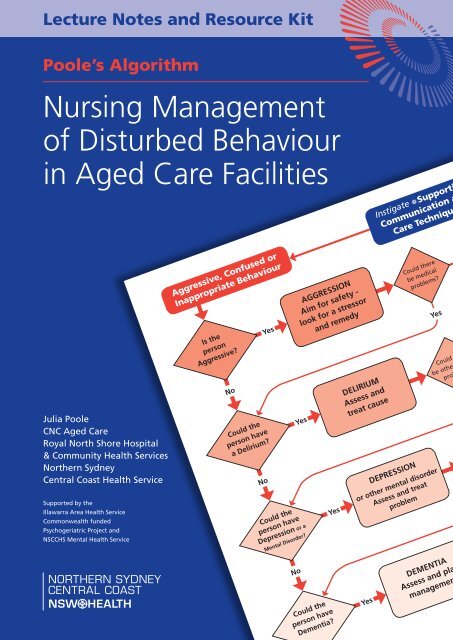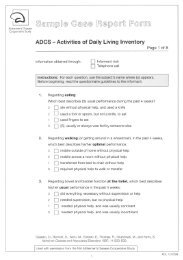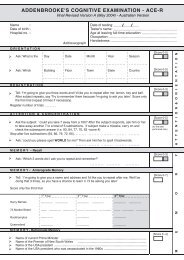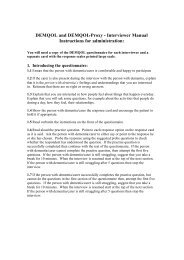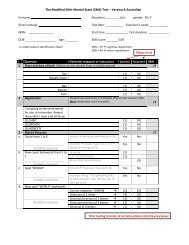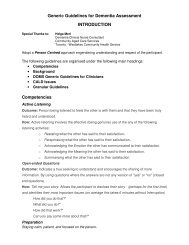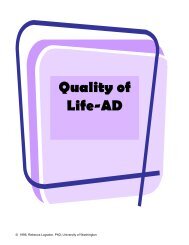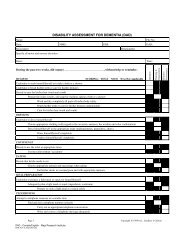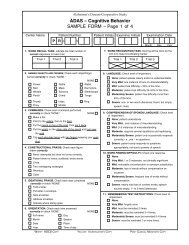Nursing Management of Disturbed Behaviour in Aged Care Facilities
Nursing Management of Disturbed Behaviour in Aged Care Facilities
Nursing Management of Disturbed Behaviour in Aged Care Facilities
You also want an ePaper? Increase the reach of your titles
YUMPU automatically turns print PDFs into web optimized ePapers that Google loves.
Lecture Notes and Resource Kit<br />
Poole’s Algorithm<br />
<strong>Nurs<strong>in</strong>g</strong> <strong>Management</strong><br />
<strong>of</strong> <strong>Disturbed</strong> <strong>Behaviour</strong><br />
<strong>in</strong> <strong>Aged</strong> <strong>Care</strong> <strong>Facilities</strong><br />
Julia Poole<br />
CNC <strong>Aged</strong> <strong>Care</strong><br />
Royal North Shore Hospital<br />
& Community Health Services<br />
Northern Sydney<br />
Central Coast Health Service<br />
Supported by the<br />
Illawarra Area Health Service<br />
Commonwealth funded<br />
Psychogeriatric Project and<br />
NSCCHS Mental Health Service<br />
Aggressive, Confused or<br />
Inappropriate <strong>Behaviour</strong><br />
Is the<br />
person<br />
Aggressive?<br />
No<br />
Yes<br />
Could the<br />
person have<br />
a Delirium?<br />
No<br />
Yes<br />
Could the<br />
person have<br />
Depression or a<br />
Mental Disorder?<br />
No<br />
AGGRESSION<br />
Aim for safety -<br />
look for a stressor<br />
and remedy<br />
Yes<br />
Could the<br />
person have<br />
Dementia?<br />
DELIRIUM<br />
Assess and<br />
treat cause<br />
Yes<br />
Instigate a Supporti<br />
Communication a<br />
<strong>Care</strong> Techniqu<br />
DEPRESSION<br />
Could there<br />
be medical<br />
problems?<br />
Yes<br />
or other mental disorder<br />
Assess and treat<br />
problem<br />
Could<br />
be othe<br />
pro<br />
DEMENTIA<br />
Assess and pla<br />
managemen
Poole’s Algorithm:<br />
<strong>Nurs<strong>in</strong>g</strong> <strong>Management</strong> <strong>of</strong> <strong>Disturbed</strong> <strong>Behaviour</strong> <strong>in</strong> <strong>Aged</strong> <strong>Care</strong> <strong>Facilities</strong><br />
by Julia Poole - Cl<strong>in</strong>ical Nurse Consultant<br />
Department <strong>of</strong> <strong>Aged</strong> <strong>Care</strong> & Rehabilitation Medic<strong>in</strong>e<br />
Royal North Shore Hospital & Community Health Services<br />
Abstract<br />
The management <strong>of</strong> disturbed behaviour <strong>in</strong> older people <strong>in</strong> residential care can present great problems for<br />
nurs<strong>in</strong>g staff and may result <strong>in</strong> poor outcomes both for the resident and the staff. A review <strong>of</strong> the literature<br />
shows a general consensus that early assessment <strong>of</strong> predispos<strong>in</strong>g factors for delirium and depression,<br />
active treatment <strong>of</strong> those problems, the provision <strong>of</strong> a basic understand<strong>in</strong>g <strong>of</strong> the cognitive deficits caused<br />
by dementia and the establishment <strong>of</strong> a supportive environment, can help to facilitate contented care for all<br />
<strong>in</strong>volved. An Algorithm has been developed detail<strong>in</strong>g, <strong>in</strong> order <strong>of</strong> priority, nurs<strong>in</strong>g assessment and management<br />
<strong>of</strong> aggression, delirium, depression/or other mental disorder and dementia, plus an outl<strong>in</strong>e <strong>of</strong> ways to develop<br />
a consistent care plan for supportive communication and care. The Algorithm is presented as a colour coded<br />
poster with an explanatory education workbook.<br />
Acknowledgments<br />
Julia would like to acknowledge and thank a number <strong>of</strong> people and organisations who have supported this<br />
project and contributed to the development <strong>of</strong> the poster and manual, <strong>in</strong>clud<strong>in</strong>g:<br />
• Dr Sue Ogle, Director, Department <strong>of</strong> <strong>Aged</strong> <strong>Care</strong> and Rehabilitation Medic<strong>in</strong>e, RNSH<br />
• Peter Brown, Jane Turner, Dr Robert Russell, Cather<strong>in</strong>e Heal, Chris McMahon, L<strong>in</strong>da Latham, Jenny Chung,<br />
Donna Lewis, Michael Devery<br />
• Design and Layout: Tim Ra<strong>in</strong>ey, Medical Illustrations Department, RNSH<br />
• NSW Department <strong>of</strong> Health for funds from the State Action Plan for Dementia <strong>Care</strong> used <strong>in</strong> the pr<strong>in</strong>t<strong>in</strong>g<br />
costs <strong>of</strong> the posters<br />
• Illawarra Area Health Service, Department <strong>of</strong> Rehabilitation and <strong>Aged</strong> <strong>Care</strong> for contributions to the<br />
publish<strong>in</strong>g costs <strong>of</strong> the Lecture Notes through the Commonwealth funded Psychogeriatric Unit Project<br />
Tel no (01) 4297 1011<br />
• Eli Lilly Australia Pty Ltd for contribut<strong>in</strong>g to the publish<strong>in</strong>g costs through an unrestricted education grant.<br />
• NSCCHS Mental Health Services<br />
Enquires about the Poster and Lecture Notes Package can be directed to:<br />
The Department <strong>of</strong> <strong>Aged</strong> <strong>Care</strong> and Rehabilitation Medic<strong>in</strong>e,<br />
Royal North Shore Hospital, St Leonards, NSW 2065<br />
Tel (02) 9926 8705 Fax (02) 9906 4301<br />
First Pr<strong>in</strong>ted December 2000<br />
Repr<strong>in</strong>ts 2003, 2005, 2009<br />
Copyright © 2000<br />
The Department <strong>of</strong> <strong>Aged</strong> <strong>Care</strong> and Rehabilitation Medic<strong>in</strong>e<br />
Royal North Shore Hospital & Community Health Services<br />
ISBN No. 0-7313-9352-X
Page<br />
Poole’s Algorithm<br />
<strong>Aged</strong> <strong>Care</strong> <strong>Facilities</strong><br />
<strong>Nurs<strong>in</strong>g</strong> <strong>Management</strong> <strong>Aged</strong> <strong>Care</strong><br />
<strong>Nurs<strong>in</strong>g</strong> <strong>Management</strong> <strong>of</strong> <strong>Disturbed</strong> <strong>Behaviour</strong> In <strong>Aged</strong> <strong>Care</strong> <strong>Facilities</strong><br />
2 Learn<strong>in</strong>g outcomes<br />
3 Figure 1: the algorithm<br />
4 Aggression<br />
6 Delirium<br />
8 Depression/mental disorder<br />
10 Dementia<br />
CONTENTS<br />
12 a Supportive Communication & <strong>Care</strong><br />
14 Specific Interventions:<br />
Falls<br />
Inappropriate sexual behaviours<br />
Incont<strong>in</strong>ence<br />
Resistance to care<br />
Scream<strong>in</strong>g/call<strong>in</strong>g out<br />
Wander<strong>in</strong>g<br />
16 Reference List<br />
18 Appendix A - <strong>Behaviour</strong> Chart<br />
19 Appendix B: Geriatric Depression Scale<br />
20 Appendix C: Cornell Scale for Depression Scale <strong>in</strong> Dementia<br />
21 Appendix D: The Hayes and Lohse Non-Verbal Depression Scale<br />
22 Appendix E: Overhead Hard Copies<br />
Tables:<br />
7 Table 1: Potential causes <strong>of</strong> delirium <strong>in</strong> the Older Person<br />
7 Table 2: Delirium assessment<br />
9 Table 3: Depression/mental disorder assessment<br />
11 Table 4: <strong>Behaviour</strong>al deficits commonly observed <strong>in</strong> dementia
<strong>Nurs<strong>in</strong>g</strong> <strong>Management</strong> <strong>Aged</strong> <strong>Care</strong><br />
Poole’s Algorithm:<br />
<strong>Nurs<strong>in</strong>g</strong> <strong>Management</strong> Of <strong>Disturbed</strong> <strong>Behaviour</strong> In <strong>Aged</strong> <strong>Care</strong> <strong>Facilities</strong><br />
After tak<strong>in</strong>g part <strong>in</strong> this educational session, participants will be able to expla<strong>in</strong> the use <strong>of</strong> Poole’s<br />
Algorithm to prioritise assessment and management <strong>of</strong> disturbed behaviour <strong>in</strong> older people.<br />
Learn<strong>in</strong>g Outcomes<br />
1. Expla<strong>in</strong> the pr<strong>in</strong>ciples <strong>of</strong> aggression management<br />
2. Def<strong>in</strong>e the terms delirium, depression, mental disorder and dementia<br />
3. Justify the order <strong>of</strong> assessment procedures<br />
4. Outl<strong>in</strong>e nurs<strong>in</strong>g assessment and management procedures<br />
5. Identify the major types <strong>of</strong> dementia<br />
6. Describe the common cognitive deficits caused by dementia<br />
7. Outl<strong>in</strong>e the requirements for provid<strong>in</strong>g care plans for older people with disturbed behaviour.
<strong>Nurs<strong>in</strong>g</strong> <strong>Management</strong> <strong>Aged</strong> <strong>Care</strong><br />
Figure : Poole’s Algorithm:<br />
<strong>Nurs<strong>in</strong>g</strong> <strong>Management</strong> <strong>of</strong> <strong>Disturbed</strong> <strong>Behaviour</strong> <strong>in</strong> Older People<br />
Aggressive, Confused or<br />
Inappropriate <strong>Behaviour</strong><br />
Is the<br />
person<br />
Aggressive?<br />
No<br />
Could the<br />
person have<br />
a Delirium?<br />
No<br />
Could the<br />
person have<br />
Depression or a<br />
Mental Disorder?<br />
No<br />
Could the<br />
person have<br />
Dementia?<br />
Yes<br />
Yes<br />
Yes<br />
Yes<br />
AGGRESSION<br />
Aim for safety -<br />
look for a stressor<br />
and remedy<br />
DELIRIUM<br />
Assess and<br />
treat cause<br />
DEPRESSION<br />
or other mental disorder<br />
Assess and treat<br />
problem<br />
DEMENTIA<br />
Assess and plan<br />
management<br />
Instigate a Supportive<br />
Communication and<br />
<strong>Care</strong> Techniques<br />
Could there<br />
be medical<br />
problems?<br />
Yes<br />
Could there<br />
be other medical<br />
problems?<br />
Yes<br />
Could there<br />
be other medical<br />
problems?<br />
Yes<br />
Plan<br />
ongo<strong>in</strong>g<br />
care<br />
No<br />
No<br />
No<br />
Yes<br />
(c) Julia Poole RNSH & CHS
<strong>Nurs<strong>in</strong>g</strong> <strong>Management</strong> <strong>Aged</strong> <strong>Care</strong><br />
AGGRESSIVE, CONFUSED OR<br />
INAPPROPRIATE BEHAVIOUR<br />
Priorities for <strong>Management</strong> and Assessment<br />
Is the person AGGRESSIVE?<br />
If ‘YES’ If ‘NO” go to next section page 6<br />
AGGRESSION<br />
Aim for SAFETY: Look for a stressor and remedy.<br />
Overall approach: Non-Confrontation<br />
1. Give person space (stand back)<br />
Calm, friendly, empathic approach,<br />
Meet the need or divert the attention<br />
2. If Problem Persists - CALL for ASSISTANCE<br />
(Note the facility policy on use <strong>of</strong> restra<strong>in</strong>t)<br />
3. Don’t hesitate to call ‘Security’ if any danger.<br />
4. Afterwards evaluate (<strong>Behaviour</strong> Chart)<br />
5. Debrief<br />
6. Plan management<br />
7. Follow the arrows >>><br />
8. Instigate a Supportive Communication & <strong>Care</strong> Techniques<br />
An aggressive <strong>in</strong>cident must be defused before assessment and treatment can take place.<br />
Nurses have traditionally tended to approach their patients <strong>in</strong> a ‘custodial manner’ and<br />
psychosocial <strong>in</strong>terventions receive little attention [1]. This can contribute to disturbed behaviour result<strong>in</strong>g<br />
<strong>in</strong> aggressive <strong>in</strong>cidents especially by vulnerable people with sensory deficits or reduced neurological reserves.<br />
The immediate approach should be to AIM for SAFETY and LOOK FOR A STRESSOR AND REMEDY, but be<br />
NON-CONFRONTATIONAL.
<strong>Nurs<strong>in</strong>g</strong> <strong>Management</strong> <strong>Aged</strong> <strong>Care</strong><br />
1. GIVE the PERSON SPACE (Stand Back) [2]. Those <strong>in</strong>volved should stop do<strong>in</strong>g whatever appears<br />
to be associated with the behaviour (e.g. chang<strong>in</strong>g a dress<strong>in</strong>g), move out <strong>of</strong> range and remove any<br />
obvious stressors (e.g. people, equipment, noise, pa<strong>in</strong> etc). However, it is particularly important to<br />
remember that if the situation is out <strong>of</strong> control and seems dangerous, then staff need to know how<br />
access the SECURITY arrangements <strong>of</strong> their particular establishment.<br />
The person may <strong>in</strong> fact be very frightened [2]. Despite any misgiv<strong>in</strong>gs you may have, you should<br />
endeavour to settle a tense situation by modell<strong>in</strong>g a CALM, FRIENDLY, EMPATHIC APPROACH,<br />
us<strong>in</strong>g the preferred name and by not argu<strong>in</strong>g or disagree<strong>in</strong>g. Endeavour to empathise (“I can see<br />
you are upset. Can I help you?”) and be particularly careful to listen to their reply and <strong>in</strong>vestigate any<br />
claims or accusations [3]. Bizarre th<strong>in</strong>gs do happen. Always consider contact<strong>in</strong>g the family and /or <strong>of</strong>fer<br />
a phone call. The ma<strong>in</strong> aim is to MEET THE IMMEDIATE NEED as appropriately as possible, as sense will<br />
not prevail until that is satisfied. Th<strong>in</strong>k creatively and laterally about how you can meet the need safely.<br />
It may be helpful to attempt to DIVERT THE ATTENTION, particularly if there could be an element<br />
<strong>of</strong> dementia <strong>in</strong>volved [4]. This might mean just walk<strong>in</strong>g away and return<strong>in</strong>g with a different, smil<strong>in</strong>g<br />
approach, or ask<strong>in</strong>g someone else to take over, or by chang<strong>in</strong>g the activity, or <strong>of</strong>fer<strong>in</strong>g food or dr<strong>in</strong>k<br />
or a walk or company etc.<br />
2. IF the PROBLEM PERSISTS it is important to seek help from senior staff and/or the medical <strong>of</strong>ficer<br />
and/or the family, quickly. If necessary, consider chemical or mechanical restra<strong>in</strong>t <strong>in</strong> the least restrictive<br />
manner possible [3]. The last resort <strong>of</strong> mechanical restra<strong>in</strong>t <strong>in</strong>creases the need for supervision plus the<br />
facility’s policy must be followed scrupulously - especially the need for a written medical order, the<br />
consent <strong>of</strong> relatives, frequent reassurance plus an observation and release time frame. The short<br />
term use <strong>of</strong> medications such as haloperidol (0.5-2mg) with small doses repeated <strong>of</strong>ten, is suggested<br />
[5,6,7,8]. <strong>Care</strong>ful monitor<strong>in</strong>g for signs <strong>of</strong> effectiveness or the development <strong>of</strong> Park<strong>in</strong>sonian or<br />
extrapyramidal features is essential (e.g. facial spasms, restlessness, tremor, rigidity, stooped posture etc).<br />
3. Don’t hesitate to call for help from the facility’s designated SECURITY staff if any real danger<br />
persists. A policy and protocol should be <strong>in</strong> place to support staff actions.<br />
4. Afterwards it is important to EVALUATE the event. Review and discussion is important to ensure<br />
that this <strong>in</strong>cident does not happen aga<strong>in</strong>. Documentation by way <strong>of</strong> a <strong>Behaviour</strong> Chart can be helpful<br />
<strong>in</strong> mapp<strong>in</strong>g and understand<strong>in</strong>g events [2]. This should <strong>in</strong>clude: A - the ANTECEDENT - exactly what<br />
happened before the event; B - the BEHAVIOUR - exactly what behaviour occurred; C - the CONSEQUENCES<br />
- what response was there from others? (See Appendix A).<br />
The A or Antecedent is most important and is a description <strong>of</strong> the events immediately preced<strong>in</strong>g the<br />
aggressive event, such as, ‘I shook Mr X on the arm to wake him up’ or ‘Mrs Y sat down on Mrs Z’s bed’.<br />
Look for the trigger or ‘activat<strong>in</strong>g event’ as well as patterns <strong>of</strong> activity that result from the behaviour,<br />
which could be implicated <strong>in</strong> the whole event.<br />
5. Always remember to SUPPORT the STAFF MEMBER and OTHER PEOPLE INVOLVED and arrange<br />
a time to allow them to recount their part <strong>in</strong> the <strong>in</strong>cident and ventilate their subsequent feel<strong>in</strong>gs.<br />
Incidents <strong>in</strong>volv<strong>in</strong>g aggression are frighten<strong>in</strong>g for all <strong>in</strong>volved. Staff motivation is positively enhanced<br />
when emotional needs are recognised and supported [9].<br />
6. With the ‘ABC’ <strong>in</strong> m<strong>in</strong>d, PLAN the ongo<strong>in</strong>g MANAGEMENT. Always aim for a consistent approach<br />
with consideration <strong>of</strong> the possibility <strong>of</strong> personal misunderstand<strong>in</strong>gs, varied communication skills and<br />
prejudices both <strong>in</strong> the patient and the staff. Inform the medical <strong>of</strong>ficer and facilitate assessment for<br />
delirium and/or depression or other mental disorders. At all times DOCUMENT the events clearly,<br />
particularly <strong>in</strong> the management plan and <strong>in</strong> the ongo<strong>in</strong>g CARE PLAN.<br />
Could there be medical problems?<br />
If ‘yes’ go to next section page 6, if ‘NO’ go to page 12.
<strong>Nurs<strong>in</strong>g</strong> <strong>Management</strong> <strong>Aged</strong> <strong>Care</strong><br />
Could the person have a DELIRIUM?<br />
If ‘YES’ if ‘NO’ got to next section page 8<br />
DELIRIUM<br />
ASSESS AND TREAT CAUSE<br />
Overall Approach: Support the person - def<strong>in</strong>e<br />
the acute disorder, <strong>in</strong>stigate a remedy A.S.A.P<br />
Def<strong>in</strong>ition: Delirium is an acute organic mental disorder characterised<br />
by confusion, restlessness, <strong>in</strong>coherence, anxiety or halluc<strong>in</strong>ations<br />
which may be reversible with treatment.<br />
1. Common cl<strong>in</strong>ical signs - acute, fluctuat<strong>in</strong>g, <strong>in</strong>attentive, disordered<br />
2. Potentially reversible causes - medical, environmental<br />
3. <strong>Nurs<strong>in</strong>g</strong> assessment: history, vital signs, environment.<br />
4. Document, report (seek delirium screen), <strong>in</strong>itiate appropriate treatment.<br />
5. Instigate a Supportive Communication & <strong>Care</strong> Techniques<br />
The immediate response to delirium must be to ASSESS and TREAT the CAUSE <strong>of</strong> the delirium.<br />
Therefore the OVERALL APPROACH must be to def<strong>in</strong>e the acute disorder and <strong>in</strong>stigate a REMEDY AS<br />
QUICKLY AS POSSIBLE. A wide variety <strong>of</strong> diagnostic terms have been applied to delirium. These <strong>in</strong>clude<br />
confusion, acute confusion, pseudo-dementia, reversible dementia, transient cognitive impairment,<br />
acute bra<strong>in</strong> failure, toxic psychosis, pseudosenility [8, 10, 64].<br />
Def<strong>in</strong>ition: Delirium is def<strong>in</strong>ed as an acute organic mental disorder characterised by confusion,<br />
restlessness, <strong>in</strong>coherence, anxiety or halluc<strong>in</strong>ations which may be reversible with treatment [5,11].<br />
Delirium is a common ‘precipitant <strong>of</strong> hospitalisation <strong>in</strong> the elderly’ and affects up to 50% <strong>of</strong> patients <strong>in</strong><br />
acute surgical and medical wards [12].<br />
1. COMMON CLINICAL SIGNS are summarised as:<br />
• Acute onset – changed mental status over hours or days<br />
• Fluctuation – chang<strong>in</strong>g throughout the day<br />
• Inattentiveness – easily distracted, unable to susta<strong>in</strong> attention [14]<br />
• Disordered th<strong>in</strong>k<strong>in</strong>g &/or change <strong>in</strong> consciousness – hyperalert or drowsy.<br />
Older people may have nonspecific symptoms <strong>of</strong> illness and the first sign <strong>of</strong> illnesses such as pneumonia<br />
or a ur<strong>in</strong>ary tract <strong>in</strong>fection may be delirium. The longer the delirium persists, the more the likelihood<br />
<strong>of</strong> poor outcomes with serious complications and even death [12, 13].<br />
2. POTENTIALLY REVERSIBLE CAUSES OF DELIRIUM IN THE OLDER PERSON are <strong>of</strong>ten mis<strong>in</strong>terpreted<br />
and nurses can be the first to raise suspicions and avoid the trap <strong>of</strong> the <strong>in</strong>accurate conclusions that<br />
the person only has problems related to dementia [13]. Information from an accurate history and<br />
assessment are essential to ascerta<strong>in</strong> a basel<strong>in</strong>e state. Some people are more likely (predisposed)<br />
to develop<strong>in</strong>g delirium (see Table 1)
Table 1: Potential causes (predispos<strong>in</strong>g & precipitat<strong>in</strong>g) <strong>of</strong> delirium <strong>in</strong> the older person<br />
<strong>Nurs<strong>in</strong>g</strong> <strong>Management</strong> <strong>Aged</strong> <strong>Care</strong><br />
Predispos<strong>in</strong>g Precipitat<strong>in</strong>g<br />
Poor sight Infections - UTI, pneumonia, cellulitis, etc<br />
Severe illness (<strong>in</strong>cl. depression) Fluid & Electrolyte imbalance<br />
Cognitive impairment Hypoxia<br />
Dehydration Constipation/diarrhoea<br />
Ur<strong>in</strong>ary retention<br />
Uncontrolled pa<strong>in</strong><br />
Sleep deprivation<br />
Abnormal glucose levels<br />
Side effects/toxicity <strong>of</strong> medications<br />
Sensory deprivation/overload (<strong>in</strong>cl. IDC , restra<strong>in</strong>t & surgical procedures)<br />
WITHDRAWAL FROM ALCOHOL or DRUGS [7, 12]<br />
3. Therefore the NURSING ASSESSMENT would need to <strong>in</strong>clude –<br />
Table 2: Delirium assessment<br />
• Level <strong>of</strong> consciousness - if clouded, this is a medical emergency - notify a medical <strong>of</strong>ficer.<br />
• Past documentation <strong>of</strong> previous cognitive /behavioural state - case notes, GP, family,<br />
nurs<strong>in</strong>g home/hostel.<br />
• Cognitive mental status - assess orientation. The Folste<strong>in</strong> M<strong>in</strong>i Mental Status Exam (MMSE)<br />
is <strong>of</strong>ten the preferred tool [5] but others <strong>in</strong>clude the Hodk<strong>in</strong>son Abbreviated Mental Test Score<br />
(AMTS) [15], the CLOCK [65], the M<strong>in</strong>iCog [66 and the SIS [67].<br />
• The Confusion Assessment Method (CAM) [14] is available to enable non psychiatric cl<strong>in</strong>icians to<br />
detect delirium symptoms.<br />
• Physical f<strong>in</strong>d<strong>in</strong>gs - temperature, pulse, respirations, BP, U/A, BSL, SaO2, sk<strong>in</strong> turgor and colour,<br />
ur<strong>in</strong>ary output, bowel status. Full body exam<strong>in</strong>ation <strong>in</strong>clud<strong>in</strong>g mouth and ears. Tests ordered by<br />
the medical <strong>of</strong>ficer for a Delirium Screen might <strong>in</strong>clude: MSU, full blood count, differential and<br />
ESR, electrolytes, urea and creat<strong>in</strong><strong>in</strong>e, thyroid function tests, liver function tests, cardiac enzymes,<br />
calcium, cultures specific to the symptoms (e.g. wound swab). Second l<strong>in</strong>e <strong>in</strong>vestigations might<br />
<strong>in</strong>clude chest x-ray, ECG, CT head scan, ultrasound, EEG, B12 and folate levels. Lithium, Tegretol<br />
and Digox<strong>in</strong> levels should be tested if on these drugs. Other useful tests <strong>in</strong>clude blood gases,<br />
blood cultures, drugs screen and C-reactive prote<strong>in</strong> [7].<br />
• Medication history - note the current medications, both prescription and ‘over-the-counter’<br />
as well as compliance – does the person always take them as prescribed?<br />
• Pa<strong>in</strong> level - elderly people are known for their stoicism and the possible fear <strong>of</strong> nurs<strong>in</strong>g home<br />
placement, so do not always admit to severe pa<strong>in</strong> [16].<br />
• Sensory status - sight and/or hear<strong>in</strong>g deficits. Always check whether hear<strong>in</strong>g aids and glasses<br />
are needed, work<strong>in</strong>g or miss<strong>in</strong>g.<br />
• Environmental impact – consider the impact <strong>of</strong> noise, light, unfamiliarity, isolation, boredom,<br />
immobility.<br />
• Social problems - the stress caused by the <strong>in</strong>creas<strong>in</strong>g losses <strong>in</strong> old age can cause behavioural changes [17].<br />
4. DOCUMENT f<strong>in</strong>d<strong>in</strong>gs, REPORT to a medical <strong>of</strong>ficer for Delirium Screen and medication review.<br />
INITIATE APPROPRIATE TREATMENT with<strong>in</strong> nurs<strong>in</strong>g guidel<strong>in</strong>es.<br />
‘Whilst accurate diagnosis may <strong>of</strong>ten depend on laboratory tests and the occasional use <strong>of</strong> high<br />
technology scans, the pr<strong>in</strong>ciple skill lies <strong>in</strong> sympathetic handl<strong>in</strong>g and an appropriate bedside manner<br />
from all <strong>in</strong>volved’ [7].<br />
Could there be other medical problems?<br />
If ‘YES’ go to next section page 8, if ‘NO’ go to page 12.
<strong>Nurs<strong>in</strong>g</strong> <strong>Management</strong> <strong>Aged</strong> <strong>Care</strong><br />
Could the person have DEPRESSION or other mental disorder?<br />
If ‘YES’ If ‘NO’ go to next section page 10.<br />
DEPRESSION/ Mental Disorder<br />
ASSESS AND TREAT PROBLEM<br />
Overall Approach: Support the person - def<strong>in</strong>e<br />
the acute disorder, <strong>in</strong>stigate remedy a.s.a.p.<br />
Def<strong>in</strong>ition: Depression is an abnormal emotional state characterised<br />
by exaggerated feel<strong>in</strong>gs <strong>of</strong> sadness, worthlessness and hopelessness<br />
which are out <strong>of</strong> proportion with reality.<br />
A Mental Disorder is a disturbance <strong>of</strong> emotional equilibrium manifested<br />
by maladaptive behaviour & impaired function<strong>in</strong>g.<br />
1. <strong>Nurs<strong>in</strong>g</strong> assessment - question and describe - use screen<strong>in</strong>g tools<br />
2. Obta<strong>in</strong> history - previous and predispos<strong>in</strong>g<br />
3. Document & report to medical <strong>of</strong>ficer<br />
4. Observe person for deterioration - support<br />
5. Instigate a Supportive Communication & <strong>Care</strong> Techniques<br />
The need is to ASSESS AND TREAT the PROBLEM. The OVERALL APPROACH is to SUPPORT<br />
THE PERSON whilst def<strong>in</strong><strong>in</strong>g the acute disorder and <strong>in</strong>stigat<strong>in</strong>g a remedy as quickly as possible.<br />
Def<strong>in</strong>ition: Depression is an abnormal emotional state characterised by exaggerated feel<strong>in</strong>gs <strong>of</strong> sadness,<br />
worthlessness and hopelessness which are out <strong>of</strong> proportion with reality and are present for at least<br />
two weeks [18,5].<br />
A Mental Disorder is a disturbance <strong>of</strong> emotional equilibrium manifested by maladaptive behaviour<br />
and impairment [5, 19].<br />
Depression is <strong>of</strong>ten associated with self neglect and physical illness as well as be<strong>in</strong>g complicated by the side<br />
effects <strong>of</strong> antichol<strong>in</strong>ergic tricyclic drug treatment. Depression usually presents as a gradual onset with mild<br />
cognitive impairment, worse <strong>in</strong> the morn<strong>in</strong>g with improvement towards the end <strong>of</strong> the day and is present<br />
over at least the last two weeks. It may be differentiated from delirium which presents as an acute onset<br />
with fluctuat<strong>in</strong>g symptoms that worsen towards the end <strong>of</strong> the day [20]. To aid accurate diagnosis, it is<br />
better to describe the actual signs and symptoms rather than just say that the person appears depressed.
1. The NURSING ASSESSMENT needs to <strong>in</strong>clude:<br />
Table 3: Elements <strong>of</strong> a depression/mental disorder assessment<br />
Is the person -<br />
<strong>Nurs<strong>in</strong>g</strong> <strong>Management</strong> <strong>Aged</strong> <strong>Care</strong><br />
• Express<strong>in</strong>g any ideas <strong>of</strong> harm to self or others - ‘life is not worth liv<strong>in</strong>g’, ‘I wish I was dead’,<br />
‘helpless’, ‘hopeless’, ‘worthless’, OR aggressive statements? Ask specific questions regard<strong>in</strong>g<br />
suicidal <strong>in</strong>tent or plans (if present - ma<strong>in</strong>ta<strong>in</strong> close observation and notify medical <strong>of</strong>ficer<br />
urgently). Consider us<strong>in</strong>g depression screen<strong>in</strong>g tools e.g. the Geriatric Depression Scale [29],<br />
Cornell Scale for Depression <strong>in</strong> Dementia [31], Non-verbal Depression Scale (30].<br />
See Appendices B, C and D.<br />
• Sad (facial expression, posture) – tearful, worse <strong>in</strong> the morn<strong>in</strong>g or even<strong>in</strong>g?<br />
• Anxious – changes <strong>in</strong> eat<strong>in</strong>g and sleep<strong>in</strong>g patterns, lethargic/apathetic, agitated?<br />
• Rum<strong>in</strong>at<strong>in</strong>g – go<strong>in</strong>g on and on about someth<strong>in</strong>g?<br />
• Halluc<strong>in</strong>at<strong>in</strong>g – visual, tactile, auditory or olfactory?<br />
• Grandiose, delusional, paranoid – ‘people are talk<strong>in</strong>g about me’, suspicious <strong>of</strong> motives <strong>of</strong> other<br />
people or staff, poisoned food or drugs? [5,18]<br />
2. OBTAIN A HISTORY OF:<br />
• Previous mental state and any previous mental illness or psychiatric admissions<br />
• Previous medication regime and compliance with treatment<br />
• Any predispos<strong>in</strong>g factors such as family or f<strong>in</strong>ancial problems<br />
• Any grief or loss situations.<br />
It is particularly important to liaise with the patient’s family and also the staff <strong>of</strong> the retirement village<br />
or nurs<strong>in</strong>g home as well, who <strong>of</strong>ten have an <strong>in</strong>-depth knowledge <strong>of</strong> the patient’s usual status and<br />
cop<strong>in</strong>g skills. However, the appropriate duty <strong>of</strong> care and the ‘need to know’ pr<strong>in</strong>ciple must be<br />
considered to avoid problems with confidentiality.<br />
3. DOCUMENT f<strong>in</strong>d<strong>in</strong>gs and report to a medical <strong>of</strong>ficer for referral for a mental health<br />
consultation and treatment. Tricyclic antidepressant medications have been superseded by other<br />
classes <strong>of</strong> drugs (such as, the SSRIs – for example fluoxet<strong>in</strong>e and sertral<strong>in</strong>e etc) which have less side<br />
effects [18]. Consideration <strong>of</strong> a trial <strong>of</strong> medication for symptoms <strong>of</strong> depression that do not resolve<br />
spontaneously after two or three weeks, is recommended<br />
4. OBSERVE THE PERSON FOR SIGNS OF DETERIORATION.<br />
Support, reassure and <strong>in</strong>vestigate any claims or accusations. Encourage the person to talk about their<br />
worries. One <strong>of</strong> the most important nurs<strong>in</strong>g skills is that <strong>of</strong> therapeutic conversation [21]. The ability to<br />
provide a non judgemental ‘listen<strong>in</strong>g ear’ with appropriate reflection is therapeutic.<br />
Could there be other medical problems?<br />
If ‘YES” go to the next section page 10, if ‘NO’ go to page 12.
<strong>Nurs<strong>in</strong>g</strong> <strong>Management</strong> <strong>Aged</strong> <strong>Care</strong><br />
Could the person have DEMENTIA?<br />
If ‘YES’ If ‘NO’ go to next section page 12.<br />
DEMENTIA<br />
ASSESS AND PLAN MANAGEMENT<br />
Overall Approach: Empathic support, modification<br />
<strong>of</strong> communication and the environment.<br />
Def<strong>in</strong>ition: Dementia is a cl<strong>in</strong>ical syndrome <strong>of</strong> organic orig<strong>in</strong>,<br />
characterised by a slow onset <strong>of</strong> decl<strong>in</strong>e <strong>in</strong> multiple cognitive functions,<br />
particularly <strong>in</strong>tellect and memory, which occur <strong>in</strong> clear consciousness<br />
and causes dysfunction <strong>in</strong> daily liv<strong>in</strong>g;<br />
1. Medical diagnosis - most common, less common, small group<br />
2. <strong>Nurs<strong>in</strong>g</strong> Assessment - deficits affect<strong>in</strong>g behaviour<br />
3. Instigate a Supportive Communication and <strong>Care</strong> Techniques<br />
4. Document and notify Med. Officer if a Supportive Communication<br />
and <strong>Care</strong> Techniques are not successful.<br />
DEMENTIA is the f<strong>in</strong>al consideration after delirium and depression or other mental disorders.<br />
The need is to ASSESS and PLAN the MANAGEMENT. The Overall Approach is to provide<br />
EMPATHIC SUPPORT and MODIFICATION OF COMMUNICATION AND THE ENVIRONMENT.<br />
Def<strong>in</strong>ition: Dementia is a cl<strong>in</strong>ical syndrome <strong>of</strong> organic orig<strong>in</strong>, characterised by a slow onset <strong>of</strong> decl<strong>in</strong>e <strong>in</strong><br />
multiple cognitive functions, particularly <strong>in</strong>tellect and memory, which occur <strong>in</strong> clear consciousness and cause<br />
dysfunction <strong>in</strong> daily liv<strong>in</strong>g [6, 22].<br />
It has been thought that approximately 50% <strong>of</strong> people with dementia have Alzheimer’s Disease (which<br />
can only be def<strong>in</strong>itively diagnosed by bra<strong>in</strong> biopsy <strong>in</strong> which neur<strong>of</strong>ibrillary tangles and amyloid plaques are<br />
found); approx. 25% have vascular dementia; approx. 20% have a mixture <strong>of</strong> the two and approx. 5% have<br />
a rare diseases such as Pick’s Disease, Hunt<strong>in</strong>gton’s Chorea or Creutzfeld Jacob Disease etc [23].<br />
However, there has been <strong>in</strong>creased recognition <strong>of</strong> the prevalence <strong>of</strong> Diffuse Lewy Body Dementia.<br />
The features overlap those <strong>of</strong> Alzheimer’s Disease but <strong>in</strong>clude fluctuations <strong>of</strong> cognition or alertness,<br />
halluc<strong>in</strong>ations, extrapyramidal features such as rigidity, as well as a pronounced sensitivity to neuroleptic<br />
medication [6, 57].<br />
Although most types <strong>of</strong> dementia are chronic and progressive, there is a small group (<strong>in</strong>clud<strong>in</strong>g Vit B 12<br />
and folate deficiencies, normal-pressure hydrocephalus and hypothyroidism etc.) which are theoretically<br />
‘reversible’ if diagnosed and treated early enough [6].<br />
Advances <strong>in</strong> recent research have <strong>in</strong>cluded the development <strong>of</strong> medications which may slow the progression<br />
<strong>of</strong> symptoms <strong>of</strong> Alzheimer’s Disease (for example Donepezil and Rivastigm<strong>in</strong>e) [63].<br />
Dementia is described as a ‘loss <strong>of</strong> self’ [24] or a condition <strong>in</strong> which the environment becomes<br />
<strong>in</strong>creas<strong>in</strong>gly foreign - rather like liv<strong>in</strong>g <strong>in</strong> a bad dream - caus<strong>in</strong>g a progressively lowered stress threshold<br />
[25] . However, long term memories and behaviours rema<strong>in</strong> the longest and can be utilised to facilitate<br />
adaptation for cop<strong>in</strong>g with the deficits. Consider<strong>in</strong>g the behaviour empathically or from the person’s<br />
perspective, fosters greater understand<strong>in</strong>g, patience and tolerance [26, 27].<br />
0
<strong>Nurs<strong>in</strong>g</strong> <strong>Management</strong> <strong>Aged</strong> <strong>Care</strong><br />
<strong>Behaviour</strong>al assessment is important to f<strong>in</strong>d specific deficits so that supportive care plans can be developed.<br />
These would endeavour to modify the environmental problems (signs, colours, pictures, light, room layout)<br />
and communication difficulties, by provid<strong>in</strong>g constant clues to reality (therapeutic conversation) as well<br />
as validation <strong>of</strong> thoughts and feel<strong>in</strong>gs. People with dementia need constant, sensitive direction and<br />
supervision, to compensate for their decl<strong>in</strong><strong>in</strong>g ability to plan, <strong>in</strong>itiate and regulate [4, 28, 62].<br />
1. MEDICAL diagnosis requires documentation <strong>of</strong> a decl<strong>in</strong>e <strong>in</strong> cognition from a previous level,<br />
exam<strong>in</strong>ation <strong>of</strong> the process caus<strong>in</strong>g the decl<strong>in</strong>e and elim<strong>in</strong>ation <strong>of</strong> other causes.<br />
2. The NURSING ASSESSMENT requires the identification <strong>of</strong> specific behavioural problems<br />
(remember that this person will always have a degree <strong>of</strong> transition stress when admitted for acute care).<br />
Table 4: <strong>Behaviour</strong>al deficits commonly observed <strong>in</strong> dementia.<br />
The effect <strong>of</strong> cognitive deficits may be:<br />
• Memory Loss - unable to remember words that are read, seen or heard; recent memories,<br />
people and events quickly forgotten - recent events simply do not exist.<br />
• Language expression - unable to use language (speech, writ<strong>in</strong>g and read<strong>in</strong>g) to communicate;<br />
difficulty say<strong>in</strong>g precisely what they want to say or nam<strong>in</strong>g common objects or difficulty<br />
understand<strong>in</strong>g what is said to them.<br />
• Spatial awareness - unable to locate the position <strong>of</strong> the person or objects <strong>in</strong> space;<br />
difficulty know<strong>in</strong>g how to f<strong>in</strong>d their way.<br />
• Apraxia – difficulties <strong>in</strong> carry<strong>in</strong>g out planned or learned patterns <strong>of</strong> movement; difficulty<br />
<strong>in</strong> putt<strong>in</strong>g on clothes <strong>in</strong> the correct order or us<strong>in</strong>g appliances or mak<strong>in</strong>g the bed.<br />
• Agnosia - difficulties <strong>in</strong> recognis<strong>in</strong>g th<strong>in</strong>gs and people, such as family members, objects<br />
(such as knife & fork), surround<strong>in</strong>gs (such as their house).<br />
• Insight - unable to plan or organise; may shop without money, be unaware <strong>of</strong> the state<br />
<strong>of</strong> untid<strong>in</strong>ess <strong>of</strong> their house or dress <strong>in</strong>appropriately.<br />
• Initiation - unable to start an action, such as eat<strong>in</strong>g a meal; may appear apathetic, unable to<br />
understand, unmotivated.<br />
• Perseveration - unable to stop do<strong>in</strong>g or say<strong>in</strong>g someth<strong>in</strong>g; repeats questions, statements, actions.<br />
• Regulation - unable to keep on track or control social behaviour; easily distracted, wanders,<br />
talks over others.<br />
• Connection - unable to connect behaviours, emotions and memories, angry responses,<br />
accusations <strong>of</strong> steal<strong>in</strong>g [23].<br />
3. PLAN ONGOING CARE by <strong>in</strong>stigat<strong>in</strong>g Supportive Communication and <strong>Care</strong> Techniques. See page 12.<br />
4. DOCUMENT f<strong>in</strong>d<strong>in</strong>gs and notify a medical <strong>of</strong>ficer if Supportive Communication and <strong>Care</strong> techniques<br />
are not restor<strong>in</strong>g improved well be<strong>in</strong>g. Medications may be helpful (small doses - usually haloperidol<br />
0.5mg - 2.0mg stat & prn or newer medications such as, risperidone or olanzap<strong>in</strong>e). Whilst the use <strong>of</strong><br />
medication is best avoided <strong>in</strong> the long term - the stresses imposed by illness or relocation which may<br />
cause agitated behaviour, may be m<strong>in</strong>imised by small doses <strong>of</strong> a non sedat<strong>in</strong>g medication <strong>in</strong> the<br />
short term [6, 41].<br />
Proceed to page 12.
<strong>Nurs<strong>in</strong>g</strong> <strong>Management</strong> <strong>Aged</strong> <strong>Care</strong><br />
a Supportive Communication & <strong>Care</strong><br />
How to develop a care plan for consistent care.<br />
a Supportive Communication & <strong>Care</strong><br />
Overall Approach: Show RESPECT AND EMPATHY - to re<strong>in</strong>force and<br />
re<strong>in</strong>state the person’s sense <strong>of</strong> DIGNITY and IDENTITY.<br />
1. Gather <strong>in</strong>formation<br />
2. Encourage family <strong>in</strong>volvement<br />
3. Bra<strong>in</strong> storm ideas for care<br />
4. Instigate consistent care plan<br />
5. Use careful communication skills<br />
6. Adapt the environment<br />
7. Provide activity program<br />
8. Consider medication<br />
9. Encourage <strong>in</strong>dependence and mobility<br />
10. Normalise sleep-wake cycle<br />
11. Document, monitor and evaluate.<br />
The fear <strong>of</strong> loss <strong>of</strong> dignity is reported to be the major reason for requests for euthanasia by people with a<br />
term<strong>in</strong>al illness - not necessarily fear <strong>of</strong> <strong>in</strong>tractable pa<strong>in</strong> as one might expect. In dementia and delirium, the<br />
first loss is one <strong>of</strong> dignity as the person endeavours to ma<strong>in</strong>ta<strong>in</strong> their sense <strong>of</strong> reality, freedom and control,<br />
<strong>in</strong> an environment <strong>in</strong> which normality is slipp<strong>in</strong>g beyond reach. ‘Where am I? Who are you? What are you<br />
do<strong>in</strong>g? Why?’ For elderly people with a lifetime <strong>of</strong> competence and achievement beh<strong>in</strong>d them, this can<br />
cause overwhelm<strong>in</strong>g anxiety, if not outright fear, and stimulate well developed defence mechanisms [27].<br />
1. Gather <strong>in</strong>formation<br />
• medical history – liaise with GP, what affects the person’s life?<br />
• social history – what important th<strong>in</strong>gs have happened & what do they like to do?<br />
• functional ability – what can they do?<br />
• spiritual needs – what are their usual spiritual practices?<br />
• Observe and describe the behaviour<br />
• Record a <strong>Behaviour</strong> Chart (ABC)<br />
• Look for Antecedents (triggers)and re<strong>in</strong>forc<strong>in</strong>g events.[2,32]<br />
2. Encourage family <strong>in</strong>volvement<br />
• Expla<strong>in</strong> the facility rout<strong>in</strong>e to the family<br />
• Ask for help <strong>in</strong> plann<strong>in</strong>g care<br />
• Ask for details <strong>of</strong> usual rout<strong>in</strong>es, likes & dislikes<br />
• Ask for personal mementoes & photos to display by bed<br />
• Encourage contact as <strong>of</strong>ten as possible<br />
• Support family <strong>in</strong> their acceptance <strong>of</strong> events. [33, 34, 51]<br />
3. Bra<strong>in</strong>storm ideas for care<br />
• Exam<strong>in</strong>e <strong>Behaviour</strong> Chart for patterns & triggers<br />
• Discuss possible causes <strong>of</strong> behaviour <strong>in</strong> group staff meet<strong>in</strong>gs and with family<br />
• Th<strong>in</strong>k about the effect <strong>of</strong> staff <strong>in</strong>teractions, rout<strong>in</strong>es, environment<br />
• Discuss overall aims – what is a reasonable change?<br />
• Discuss possible methods <strong>of</strong> care and decide on the strategies. [34, 35]
4. Instigate consistent plan<br />
• Make sure all staff members and family are aware <strong>of</strong> the plan<br />
• Discuss plan at all handover meet<strong>in</strong>gs<br />
• Monitor consistency <strong>of</strong> approach<br />
• Plan regular evaluation and modification <strong>of</strong> care plan.[4,33]<br />
5. Use effective communication skills<br />
<strong>Nurs<strong>in</strong>g</strong> <strong>Management</strong> <strong>Aged</strong> <strong>Care</strong><br />
• Use the preferred name and make sure hear<strong>in</strong>g aid and glasses are on & <strong>in</strong> work<strong>in</strong>g order<br />
• Provide appropriate language and cultural practices with INTERPRETER help<br />
• Introduce yourself each time you approach the person<br />
• Use careful listen<strong>in</strong>g skills and PRAISE<br />
• Consider appropriate voice tone, body language, touch<br />
• Give appropriate clues to reality when us<strong>in</strong>g known social history<br />
• Accept & validate the feel<strong>in</strong>gs and ideas expressed. [35,36,37, 50]<br />
6. Adapt environment<br />
• Adapt or modify detrimental environment (? homelike, light, noise, BOREDOM etc)<br />
• Consider SECURITY measures if wander<strong>in</strong>g is likely. [34,35, 37]<br />
7. Provide activity programme<br />
• Avoid boredom and lonel<strong>in</strong>ess<br />
• Plan appropriate activity programme.<br />
• Consider discussions, rem<strong>in</strong>iscence, music, exercises, visitors. [37, 54]<br />
8. Medication<br />
• Consider medication TRIAL if depression, PAIN or psychosis is likely<br />
• If person rema<strong>in</strong>s distressed, SHORT TERM traditional or atypical psychotropic medication MAY<br />
be helpful <strong>in</strong> small doses repeated <strong>of</strong>ten, but must be closely monitored for Park<strong>in</strong>sonian<br />
side-effects which are particularly likely <strong>in</strong> Lewy Body Disease.<br />
• Seek expert advice.[16,39,40, 41]<br />
9. Independence and mobility<br />
• Encourage person to do as much as possible for themselves<br />
• Encourage participation <strong>in</strong> exercise programme<br />
• Ma<strong>in</strong>ta<strong>in</strong> dignity and promote self confidence<br />
• Prevent loss <strong>of</strong> strength. [42]<br />
10. Normalise sleep-wake cycles<br />
• SHORT rest period only <strong>in</strong> the afternoon<br />
• Exercise, stimulation & sunsh<strong>in</strong>e dur<strong>in</strong>g the day<br />
• Use bedroom for sleep only<br />
• Avoid caffe<strong>in</strong>e but provide light snack <strong>in</strong> even<strong>in</strong>g<br />
• Provide help and reassurance with toilet<strong>in</strong>g and orientation at night<br />
• Accept that a person may be wakeful at night and provide reassurance and gentle activities<br />
such as favourite music [43].<br />
11. Document, monitor and evaluate<br />
• All care and changes MUST be documented<br />
• Confused people cannot tell you what is wrong with them & cannot ask for help, particularly with<br />
PAIN management<br />
• Older people have changed symptom presentation<br />
• Monitor for new delirium &/or depression<br />
• Review <strong>Care</strong> Plan daily and modify when necessary<br />
• Consult with local <strong>Aged</strong> <strong>Care</strong> team.
<strong>Nurs<strong>in</strong>g</strong> <strong>Management</strong> <strong>Aged</strong> <strong>Care</strong><br />
FALLS<br />
SPECIFIC PROBLEMS – FOLLOW THE ALGORITHM<br />
– then consider add<strong>in</strong>g the follow<strong>in</strong>g strategies:<br />
• Assess risk and reassess if change <strong>in</strong> health status<br />
• Review/reduce medication<br />
• Provide safe footwear and cloth<strong>in</strong>g<br />
• Test eyesight and glasses<br />
• Provide safe uncluttered environment<br />
• Arrange Physiotherapist assessment – balance, gait etc<br />
• Provide exercise programme<br />
• Ma<strong>in</strong>ta<strong>in</strong> walk<strong>in</strong>g aids<br />
• Consider Hip Protectors, wrist guards, helmet, knee & shoulder pads<br />
• See - Wander<strong>in</strong>g<br />
• If absolutely necessary – use restra<strong>in</strong>ts <strong>in</strong> the least restrictive way and adhere scrupulously to facility policy<br />
• See – Shanley ‘Putt<strong>in</strong>g Your Best Foot Forward – Prevent<strong>in</strong>g and Manag<strong>in</strong>g Falls <strong>in</strong> <strong>Aged</strong> <strong>Care</strong><br />
<strong>Facilities</strong>’. [34, 55]<br />
Inappropriate SEXUAL BEHAVIOURS<br />
• Consider lifetime habits, cloth<strong>in</strong>g, ur<strong>in</strong>ary tract dysfunction<br />
• Exam<strong>in</strong>e staff & resident’s reactions & debrief<br />
• Provide privacy<br />
• Provide activity programme<br />
• Provide exercise programme<br />
• Re<strong>in</strong>force appropriate behaviour<br />
• Keep verbal response to negative behaviour to a m<strong>in</strong>imum<br />
• Assess touch response – if appropriate provide stuffed animals, doll, massage, pets, etc<br />
• Increase staff <strong>in</strong>teractions with the person. [47, 48, 49, 58]<br />
INCONTINENCE<br />
• Assess over several days – when, how <strong>of</strong>ten, where, toilet<strong>in</strong>g pattern, fluid <strong>in</strong>take, <strong>in</strong>fections,<br />
medications, past history<br />
• Provide easily manageable cloth<strong>in</strong>g<br />
• Provide consistent, appropriate toilet schedule<br />
• Provide signs &/or bright colours on toilet doors<br />
• Provide protective garments and aids<br />
• Ma<strong>in</strong>ta<strong>in</strong> good hygiene<br />
• Provide privacy and time<br />
Specific Issues<br />
Specific Interventions<br />
• Falls<br />
• Inappropriate Sexual <strong>Behaviour</strong><br />
• Incont<strong>in</strong>ence<br />
• Resistance To <strong>Care</strong><br />
• Scream<strong>in</strong>g / Call<strong>in</strong>g Out<br />
• Wander<strong>in</strong>g<br />
• If faecal <strong>in</strong>cont<strong>in</strong>ence – assess for & relieve impaction.<br />
• Address fibre & fluid <strong>in</strong>take, <strong>in</strong>crease exercise, schedule to respond to gastro-colic reflex after meals<br />
• National Cont<strong>in</strong>ence Helpl<strong>in</strong>e 1800 33 00 66 [4, 52, 53]
RESISTANCE TO CARE<br />
• Review when, what, who & social history<br />
• Consider how it is be<strong>in</strong>g done, privacy, rush<br />
• ASK questions & listen to what the person is say<strong>in</strong>g<br />
• Change time it is done<br />
• Change how it is done (bathe/sponge <strong>in</strong>stead <strong>of</strong> shower)<br />
• Change carer<br />
• Provide distraction – music, s<strong>in</strong>g<strong>in</strong>g, chat<br />
• Provide gentle encouragement, reward<br />
• Compromise, simplify – change expectations<br />
• Th<strong>in</strong>k creatively and laterally. [34, 35, 36]<br />
SCREAMING/CALLING OUT<br />
• Address PAIN, toilet, lonel<strong>in</strong>ess or fear needs<br />
• Is there too little or too much stimulation?<br />
• Provide mean<strong>in</strong>gful activity programme<br />
• Consider ‘Simulated Presence Therapy’ – audio or video record<strong>in</strong>g <strong>of</strong> familiar people<br />
• Assess touch response– if appropriate provide stuffed animals, doll, massage, pets<br />
• Consider ‘white noise’- gentle ocean, bird sounds, s<strong>of</strong>t music<br />
• Surround with familiar possessions<br />
<strong>Nurs<strong>in</strong>g</strong> <strong>Management</strong> <strong>Aged</strong> <strong>Care</strong><br />
• Increase staff <strong>in</strong>teractions with the person at regular time <strong>in</strong>tervals, not only <strong>in</strong> response to calls<br />
• Validate, distract, acknowledge. [45, 46]<br />
WANDERING<br />
• Provide, safe, secure, <strong>in</strong>terest<strong>in</strong>g wander<strong>in</strong>g area (<strong>in</strong> & out)<br />
• Set up toilet<strong>in</strong>g schedule<br />
• Provide mean<strong>in</strong>gful activity programme – particularly late afternoon<br />
• Consider ‘Simulated Presence Therapy’ – audio or video <strong>of</strong> familiar people<br />
• Assess touch response– if appropriate provide stuffed animals, doll, massage, pets<br />
• See - Falls - risk protection<br />
• Surround with familiar possessions<br />
• Label own room, toilet, etc<br />
• Provide exercise programme<br />
• Camouflage exits etc<br />
• Increase staff <strong>in</strong>teractions with the person<br />
• Validate, distract, acknowledge. [37, 44]<br />
Remember:<br />
<strong>Behaviour</strong> is a means <strong>of</strong> communication.<br />
The person is not the problem<br />
The problem is the problem
<strong>Nurs<strong>in</strong>g</strong> <strong>Management</strong> <strong>Aged</strong> <strong>Care</strong><br />
Reference List<br />
1. Armstrong-Esther, C. Browne, K. and McFee, J. (1994) ‘Elderly Patients: Still and Sitt<strong>in</strong>g Quietly’, Journal <strong>of</strong> Advanced <strong>Nurs<strong>in</strong>g</strong>, Vol 19, 264-271.<br />
2. Holden, U. (1994) ‘Dementia <strong>in</strong> Acute Units:Aggression’, <strong>Nurs<strong>in</strong>g</strong> Standard, Jan.,Vol. 9, 45-50.<br />
3. Hall, G. (1991) ‘This Hospital Patient has Alzheimer’s Disease’, American Journal <strong>of</strong> <strong>Nurs<strong>in</strong>g</strong>, Oct, No. 11, 37-39.<br />
4. Harvis, K. (1990) ‘<strong>Care</strong> Plan Approach to Dementia’, Geriatric <strong>Nurs<strong>in</strong>g</strong>, March/April, 76-80.<br />
5. Gelder, M. Mayou, R. and Geddes, J. (1999) Psychiatry, Second Edition, Oxford: Oxford University Press.<br />
6. Burns, A and Hope, T. ‘Cl<strong>in</strong>ical aspects <strong>of</strong> the dementias <strong>of</strong> old age’, <strong>in</strong> Jacoby, R. and Oppenheimer, C. (eds) (1997) Psychiatry <strong>in</strong> the<br />
Elderly, Oxford: Oxford University Press.<br />
7. Mulligan, I. and Fairweather, S. ‘Delirium - The Geriatrician’s perspective’, <strong>in</strong> Jacoby, R. and Oppenheimer, C. (eds) (1997) Psychiatry<br />
<strong>in</strong> the Elderly, Oxford: Oxford University Press.<br />
8. McCabe, M. (1990) ‘From Disease to Delirium: <strong>Management</strong> <strong>of</strong> the Decl<strong>in</strong><strong>in</strong>g Elderly Patient’, Geriatrics, Vol. 45, No. 12, 28-31.<br />
9. Marquis, B. and Huston, C. (1987) <strong>Management</strong> Decision Mak<strong>in</strong>g for Nurses, Sydney: J. B. Lipp<strong>in</strong>cott Company.<br />
10. Lipowski, Z. ‘Delirium (Acute Confusional States)’, <strong>in</strong> Hazzard, W. Bierman, E. Blass, J. Ett<strong>in</strong>ger, W. Halter, J. and Andres, R. (eds)<br />
(1994) Pr<strong>in</strong>ciples <strong>of</strong> Geriatric Medic<strong>in</strong>e and Gerontology, New York: McGraw-Hill Inc.<br />
11. Gelder, M. Gath, D. Mayou, R. and Cowan, P. (1996) Oxford Textbook <strong>of</strong> Psychiatry, Oxford: Oxford University Press.<br />
12. Creasy, H. (1996) ‘Acute Confusion <strong>in</strong> the Elderly’, Current Therapeutics, August, 21-26.<br />
13. Inaba-Roland, K. and Maricle, R. (1992) ‘Assess<strong>in</strong>g Delirium <strong>in</strong> the Acute <strong>Care</strong> Sett<strong>in</strong>g’, Heart and Lung, Vol.21, No. 1.<br />
14. Inouye, S. van Dyck, C. Alessi, C. Balk<strong>in</strong>, S. Seigal, A. and Horwitz, R. (1990) ‘Clarify<strong>in</strong>g Confusion : The Confusion Assessment<br />
Method’, Annals <strong>of</strong> Internal Medic<strong>in</strong>e, Vol. 113, No. 12, 941-948.<br />
15. Hodk<strong>in</strong>son, H. (1972) ‘Evaluation <strong>of</strong> a Mental Test Score for Assessment <strong>of</strong> Mental Impairment <strong>in</strong> the Elderly’, Age and Age<strong>in</strong>g,<br />
Vol. 1, 233-238.<br />
16. Helme, R. Corran, T. and Gibson, S. (1992) ‘Pa<strong>in</strong> <strong>in</strong> the Elderly’, Proceed<strong>in</strong>gs <strong>of</strong> the 27th Annual Conference <strong>of</strong> the Australian<br />
Association <strong>of</strong> Gerontology, Melbourne.<br />
17. Feil, N. (1993) The Validation Breakthrough - Simple Techniques for Communicat<strong>in</strong>g with People with ‘Alzheimer’s-Type Dementia’,<br />
Artarmon: MacLennan & Petty Pty Ltd.<br />
18. Baldw<strong>in</strong>, R. ‘Depressive illness’, <strong>in</strong> Jacoby, R. and Oppenheimer, C. (eds) (1997) Psychiatry <strong>in</strong> the Elderly, Oxford:Oxford University Press.<br />
19. Glanze, W. Anderson, K. and Anderson, L. (1990) Mosby’s Medical, <strong>Nurs<strong>in</strong>g</strong> and Allied Health Dictionary, St Louis:The C.V. Mosby Co.<br />
20. L<strong>in</strong>dsay, J. ‘Delirium - the psychiatrist’s perspective’, <strong>in</strong> Jacoby, R. and Oppenheimer, C. (eds) (1997) Psychiatry <strong>in</strong> the Elderly, Oxford:<br />
Oxford University Press.<br />
21. Carlisle, D. (1996) ‘<strong>Care</strong>ful Talk Saves Lives’, <strong>Nurs<strong>in</strong>g</strong> Times, April 24, Vol. 92, No.17, 16.<br />
22. Department <strong>of</strong> Health, Hous<strong>in</strong>g and Community Services (1993) The Problem <strong>of</strong> Dementia <strong>in</strong> Australia, Canberra:AGPS.<br />
23. Commonwealth Dept <strong>of</strong> Human Services and Health (1994) Dementia <strong>Care</strong> Learn<strong>in</strong>g Program, Canberra: AGPS.<br />
24. Cohen, D. and Eisdorfer, C. (1986) The Loss <strong>of</strong> Self, Ontario: New American Library.<br />
25. Stolley, J. (1994) ‘When Your Patient Has Alzheimer’s Disease’, American <strong>Nurs<strong>in</strong>g</strong> Journal, Aug 6, 4-40.<br />
26. Williams, D. Wood, E. Moorleghen, F. and Chittuluru, V. (1995) ‘A Decision Model for Guid<strong>in</strong>g the <strong>Management</strong> <strong>of</strong> Disruptive<br />
<strong>Behaviour</strong>s <strong>in</strong> Demented Residents <strong>of</strong> Institutionalized Sett<strong>in</strong>gs’, The American Journal <strong>of</strong> Alzheimer’s Disease, May/June, 22-29.<br />
27. Andersson, I. Knutsson, I. and Hallberg, A. (1993) ‘The Experience <strong>of</strong> Be<strong>in</strong>g Confused: A Case Study’, Geriatric <strong>Nurs<strong>in</strong>g</strong>, Sept/Oct, 242-248.<br />
28. Rob<strong>in</strong>son, A. Spencer, B. and White, L. (1989) Understand<strong>in</strong>g Difficult <strong>Behaviour</strong>s, Michigan: Eastern Michigan University.<br />
29. Yesavage, J. Br<strong>in</strong>k, T. Rose, T. and Adey, M. (1983) ‘The Geriatric Depression Rat<strong>in</strong>g Scale: a comparison with self-report and psychiatric<br />
rat<strong>in</strong>g scales’, <strong>in</strong> Crook, T. Ferris, F. and Bartus, R. (eds) Assessment <strong>in</strong> Geriatric Psychopharmacology, Connecticutt: Mark Powley.<br />
30. Hayes, P. Lohse,D. and Bernste<strong>in</strong>, I. (1991) ‘The development and Test<strong>in</strong>g <strong>of</strong> the Hayes & Lohse Non-Verbal Depression Scale’,<br />
Cl<strong>in</strong>ical Gerontologist, Vol 10, No 3, 3-13.<br />
31. Alexopoulos, G. Abrams, R. Young, R and Ahmolan, C. ‘Cornell Scale for Depression <strong>in</strong> Dementia’ <strong>in</strong> Burns, A. Lawlor, B. and Craig, S.<br />
(1999) Assessment Scales <strong>in</strong> Old Age Psychiatry’, London: Mart<strong>in</strong> Dunitz.<br />
32. Giuliano, B. (1994) ThreePhase Therapy, Canberra: Patrick Allen.<br />
33. Taylor, B. (1998) ‘Dementia <strong>Care</strong> - how nurses rate’, Collegian, Vol. 5, No. 4, 14-21.<br />
34. Kratiuk-Wall, S. Quirke, S. Heal, C. and Shanley, C. (1996) The TECH Approach to Dementia <strong>Care</strong>, Concord: CERA.<br />
35. Bolton, R. (1986) People Skills, East Roseville:Simon & Schuster Australia.
Reference List (Cont<strong>in</strong>ued)<br />
36. Packer, T. (1999) ‘Dementia Part 3: communication’, Pr<strong>of</strong>essional Nurse, Vol.14, No.10, 727-731.<br />
37. Brown, K. (1994) I love to go a’wander<strong>in</strong>g …, Shenton Park: Independent Liv<strong>in</strong>g Centre (Inc).<br />
38. Budge, M (1989) A Wealth <strong>of</strong> Experience, Artarmon: McLennan & Petty Pty Ltd.<br />
<strong>Nurs<strong>in</strong>g</strong> <strong>Management</strong> <strong>Aged</strong> <strong>Care</strong><br />
39. Woodward, M. (1999) ‘Drug Treatments for Alzheimer’s Disease’, Australasian Journal on Age<strong>in</strong>g, Vol 18, No. 2, 59-65.<br />
40. Farrell, M. Katz, B. and Helme, R. (1996) ‘The impact <strong>of</strong> dementia on the pa<strong>in</strong> experience’, Pa<strong>in</strong>, 67, 7-15.<br />
41. Sciolla, A. and Jeste, D. (1998) ‘Use <strong>of</strong> Antipsychotics <strong>in</strong> the Elderly’, International Journal <strong>of</strong> Psychiatry <strong>in</strong> Cl<strong>in</strong>ical Practice, Vol. 2, 527-534.<br />
42. Lipski, I. (1992) ‘Immobility: Causes and Consequences’, ch. 12 <strong>in</strong> Update <strong>in</strong> Geriatric Medic<strong>in</strong>e, Edgecliffe: Excerpta Medica Aust. Pty Ltd.<br />
43. Mattesohn, M. and McConnell, E. (1988) Gerontological <strong>Nurs<strong>in</strong>g</strong>, Sydney: W.B. Saunders Co.<br />
44. Hirst, S. and Metcalf, B. (1989) ‘Whys and Whats <strong>of</strong> Wander<strong>in</strong>g’, Geriatric <strong>Nurs<strong>in</strong>g</strong>, Sept/Oct, 237-238.<br />
45. Woods, P. and Ashley, J. (1995) ‘Simulated Presence Therapy; us<strong>in</strong>g selected memories to manage problem behaviours <strong>in</strong> Alzheimer’s<br />
Disease patients’, Geriatric <strong>Nurs<strong>in</strong>g</strong>, Vol.16, No. 1, 9– 14.<br />
46. Allen-Burge, R. Stevens, A and Burgio, L (1999) ‘Effective <strong>Behaviour</strong>al Interventions for Decreas<strong>in</strong>g Dementia-Related Challeng<strong>in</strong>g<br />
<strong>Behaviour</strong> <strong>in</strong> <strong>Nurs<strong>in</strong>g</strong> Homes’, International Journal <strong>of</strong> Geriatric Psychiatry, Vol. 14, 213-232.<br />
47. Fielo, S. and Warren, S. (1997) ‘Sexual Expression <strong>in</strong> a Very Old Man: A <strong>Nurs<strong>in</strong>g</strong> Approach to <strong>Care</strong>’, Geriatric <strong>Nurs<strong>in</strong>g</strong>, Vol. 18, 61-64.<br />
48. Philo, S. Ritchie, M and Kaas, M. (1995) ‘Inappropriate Sexual <strong>Behaviour</strong>’, Journal <strong>of</strong> Gerontological <strong>Nurs<strong>in</strong>g</strong>, Vol. 22, No. 1, 117-23.<br />
49. Fielden, K. (1997) ‘Sex <strong>in</strong> Residential <strong>Care</strong> <strong>Facilities</strong>’, Lamp, Vol. 54, No. 9, 24-25.<br />
50. Acton, G. Mayhew, P. Hopk<strong>in</strong>s, B. and Yauk, S. (1999) ‘Communicat<strong>in</strong>g with Individuals with Dementia’, Journal <strong>of</strong> Gerontological<br />
<strong>Nurs<strong>in</strong>g</strong>, February, 6-13.<br />
51. Lait<strong>in</strong>en, P. (1992) ‘Participation <strong>of</strong> Informal <strong>Care</strong>givers <strong>in</strong> the Hospital <strong>Care</strong> <strong>of</strong> Elderly Patients and their Evaluations <strong>of</strong> the<br />
<strong>Care</strong> Given: Pilot Study <strong>in</strong> Three Different Hospitals’, Journal <strong>of</strong> Advanced <strong>Nurs<strong>in</strong>g</strong>, Vol. 17, 1233-1237.<br />
52. F<strong>in</strong>e, G. (1995) ‘No thanks, I’ve just been’, The Australian Cont<strong>in</strong>ence Journal, Dec., 18-19.<br />
53. Thompson, D. and Smith, D. (1998) ‘Cont<strong>in</strong>ence Restoration <strong>in</strong> the Cognitively Impaired Adult’, Geriatric <strong>Nurs<strong>in</strong>g</strong>, Vol. 19. No. 3, 87-90.<br />
54. Helmes, E and Wiancko, D. (1997) ‘Effects <strong>of</strong> Music <strong>in</strong> Reduc<strong>in</strong>g Disruptive <strong>Behaviour</strong> <strong>in</strong> a General Hospital’, presented at the<br />
16th Congress <strong>of</strong> the International Association <strong>of</strong> Gerontology, Adelaide.<br />
55. Shanley, C. (1998) Putt<strong>in</strong>g Your Best Foot Forward – Prevent<strong>in</strong>g and Manag<strong>in</strong>g Falls <strong>in</strong> <strong>Aged</strong> <strong>Care</strong> <strong>Facilities</strong>, Concord: CERA.<br />
56. Moore, S. and Buckland, A. ‘<strong>Nurs<strong>in</strong>g</strong> <strong>in</strong> old age psychiatry’, <strong>in</strong> Jacoby, R. and Oppenheimer, C. (eds) (1997) Psychiatry <strong>in</strong> the Elderly,<br />
Oxford:Oxford University Press.<br />
57. McKeith., I. Galasko, D. Wilcock, G. and Byrne, J. (1995) ‘Lewy Body Dementia –Diagnosis and Treatment’, British Journal <strong>of</strong><br />
Psychiatry, 167, 709-717.<br />
58. Verity, J. (1995) Deal<strong>in</strong>g With Inappropriate Sexual <strong>Behaviour</strong> Constructively, Mooroolbark: Dementia <strong>Care</strong> Australia Pty Ltd.<br />
59. Aarsland, D. Larsen, J. Limb, N. and Tandberg, E. (1999) ‘Olanzap<strong>in</strong>e For Psychosis In Patients With Park<strong>in</strong>son’s Disease With<br />
and Without Dementia’, Journal <strong>of</strong> Neuropsychiatry Cl<strong>in</strong>ical Neuroscience, Summer, 11,3.<br />
60. Stokes, P and Holtz, A. (1997) ‘Fluoxet<strong>in</strong>e Tenth Anniversary Update: The Progress Cont<strong>in</strong>ues’, Cl<strong>in</strong>ical Therapeutics,<br />
19 (5) September – October, 1135-1250.<br />
61. Trzepacz, P. (1998) ‘A Symptom Rat<strong>in</strong>g Scale for Delirium’, Psychiatry Research, 23, 89-97<br />
62. Keane, B. and Dixon, C. (1999) Car<strong>in</strong>g for People With Problem <strong>Behaviour</strong>s, Ascoy Vale: Ausmed Publications.<br />
63. Lim, D. (2000) ‘Current treatments for Alzheimer’s Disease’, Geriaction, Sept, Vol. 18, No. 3. 13-18<br />
64. Melbourne Health. (2006) ‘Cl<strong>in</strong>ical Practice Guidel<strong>in</strong>es for the <strong>Management</strong> <strong>of</strong> Delirium <strong>in</strong> Older People’, Melbourne: Victorian<br />
Government Department <strong>of</strong> Human Services<br />
65. Shulman, K. Gold. D, Cohen, C. & Zucchero, I. (1993) Clock-draw<strong>in</strong>g and dementia <strong>in</strong> the community: A longitud<strong>in</strong>al study.<br />
International Journal <strong>of</strong> Geriatric Psychiatry. 8(5):487-496.<br />
66. Borson, S. Scanlan, J. Brush, M. Vitaliano, P. and Dokmak, A. (2000) The m<strong>in</strong>i-cog: a cognitive ‘vital signs’ measure for<br />
dementia screen<strong>in</strong>g <strong>in</strong> multi-cultural elderly. International Journal <strong>of</strong> Geriatric Psychiatry. 15 (11):11021-1027.<br />
67. Wilber, S. T. L<strong>of</strong>gren, S. D. Mager, T.G. Blanda, M. and Gerson, L. W. (2005) An evaluation <strong>of</strong> two screen<strong>in</strong>g tools for cognitive<br />
impairment <strong>in</strong> older emergency department patients. Academic Emergency Medic<strong>in</strong>e. 12(7):612616.
Appendix A<br />
DATE TIME<br />
BEHAVIOUR<br />
B - <strong>Behaviour</strong><br />
WHAT HAPPENED BEFORE<br />
A - Anticedent<br />
WHAT HAPPENED NEXT<br />
C - Consequence<br />
LOCATION<br />
PERSONS<br />
PRESENT<br />
SIGN.<br />
Date <strong>of</strong> Birth: ........................................... Sex: ...............................<br />
(Affix patient label here)<br />
Given Names: ....................................................................................<br />
(Anticedent. <strong>Behaviour</strong>. Consequence.)<br />
Surname: .......................................... MRN: ......................................<br />
BEHAVIOUR CHART
GERIATRIC DEPRESSION SCALE Appendix B<br />
(Short Form)<br />
Name: .................................................................. D.O.B. .......................... Age: .......... Sex: ............ Date: .................................<br />
(Circle the applicable answer)<br />
1 Are you basically satisfied with your life? Yes / No<br />
2 Have you dropped many <strong>of</strong> your activities or <strong>in</strong>terests? Yes / No<br />
3 Do you feel that your life is empty? Yes / No<br />
4 Do you <strong>of</strong>ten get bored? Yes / No<br />
5 Are you <strong>in</strong> good spirits most <strong>of</strong> the time? Yes / No<br />
6 Are you afraid that someth<strong>in</strong>g bad is go<strong>in</strong>g to happen to you? Yes / No<br />
7 Do you feel happy most <strong>of</strong> the time? Yes / No<br />
8 Do you feel helpless? Yes / No<br />
9 Do you prefer to stay at home, rather than do out and do th<strong>in</strong>gs? Yes / No<br />
10 Do you feel that you have more problems with your memory than most? Yes / No<br />
11 Do you th<strong>in</strong>k it is wonderful to be alive now? Yes / No<br />
12 Do you feel pretty worthless the way you are now? Yes / No<br />
13 Do you feel full <strong>of</strong> energy? Yes / No<br />
14 Do you feel that your situation is hopeless? Yes / No<br />
15 Do you th<strong>in</strong>k that most people are better <strong>of</strong>f than you? Yes / No<br />
Scor<strong>in</strong>g<br />
Each time a question is answered <strong>in</strong> the follow<strong>in</strong>g way a po<strong>in</strong>t is scored.<br />
1 No 6 Yes 11 No<br />
2 Yes 7 No 12 Yes<br />
3 Yes 8 Yes 13 No<br />
4 Yes 9 Yes 14 Yes<br />
5 No 10 Yes 15 Yes<br />
Each answer counts for one po<strong>in</strong>t<br />
Scores greater than 5 <strong>in</strong>dicate probable depression.<br />
Where a score <strong>of</strong> more than 5 is <strong>in</strong>dicated, a more thorough cl<strong>in</strong>ical <strong>in</strong>vestigation should be undertaken.<br />
Signature <strong>of</strong> Assessor: .............................................................................................<br />
Yesavage, J. A. (1988) Geriatric Depression Scale. Psychopharmacology Bullet<strong>in</strong>. 24(4):709-711.
CORNELL SCALE FOR DEPRESSION IN DEMENTIA Appendix C<br />
Name: .................................................................. D.O.B. .......................... Age: .......... Sex: ............ Date: .................................<br />
Rat<strong>in</strong>g: Score rates are based on <strong>in</strong>formation obta<strong>in</strong>ed by cl<strong>in</strong>ician <strong>in</strong>terviews with a member <strong>of</strong> the nurs<strong>in</strong>g staff<br />
(or a carer) and the patient.<br />
Time taken: 20 m<strong>in</strong>utes with nurse or carer, 10 m<strong>in</strong>utes with patient.<br />
SCORING SYSTEM<br />
a = unable to evaluate 1 = mild or <strong>in</strong>termittent<br />
1 = absent 2 = severe<br />
Rat<strong>in</strong>gs should be based on symptoms and signs occurr<strong>in</strong>g dur<strong>in</strong>g the week prior to the <strong>in</strong>terview. No score should be<br />
given if symptoms result from physical disability or illness.<br />
A. Mood Related Signs<br />
1. Anxiety – anxious expression, rum<strong>in</strong>ations, worry<strong>in</strong>g a 0 1 2<br />
2. Sadness – sad expression, sad voice, tearfulness a 0 1 2<br />
3. Lack <strong>of</strong> reactivity to pleasant events a 0 1 2<br />
4. Irritability – easily annoyed, short tempered a 0 1 2<br />
B. <strong>Behaviour</strong>al Disturbance<br />
5. Agitation – restlessness, handwr<strong>in</strong>g<strong>in</strong>g, hairpull<strong>in</strong>g a 0 1 2<br />
6. Retardation – slow movements, slow speech, slow reactions a 0 1 2<br />
7. Multiple physical compla<strong>in</strong>ts (score 0 if GI symptoms) a 0 1 2<br />
8. Loss <strong>of</strong> <strong>in</strong>terest – less <strong>in</strong>volved <strong>in</strong> usual activities a 0 1 2<br />
(score only if change occurred acutely, i.e. <strong>in</strong> less than 1 month)<br />
C. Physical Signs<br />
9. Appetite loss – eat<strong>in</strong>g less than usual a 0 1 2<br />
10. Weight loss (score 2 if greater than 5lb or 2.5 kgm <strong>in</strong> a month) a 0 1 2<br />
11. Lack <strong>of</strong> energy – fatigues easily, unable to susta<strong>in</strong> activities a 0 1 2<br />
(score only if change occurs acutely i.e. <strong>in</strong> less than I month)<br />
D. Cyclic Functions<br />
12. Diurnal variation <strong>of</strong> mood - symptoms worse <strong>in</strong> the morn<strong>in</strong>g a 0 1 2<br />
13. Difficulty fall<strong>in</strong>g asleep – later than usual for this <strong>in</strong>dividual a 0 1 2<br />
14. Multiple awaken<strong>in</strong>gs dur<strong>in</strong>g sleep a 0 1 2<br />
15. Early morn<strong>in</strong>g awaken<strong>in</strong>g earlier than usual for this <strong>in</strong>dividual a 0 1 2<br />
E. Ideational Disturbance<br />
16. Suicide – feels life is not worth liv<strong>in</strong>g, has suicidal wishes, a 0 1 2<br />
or makes suicide attempts<br />
17. Poor self esteem - self-blame, self depreciation, feel<strong>in</strong>gs <strong>of</strong> failure a 0 1 2<br />
18. Pessimism – anticipation <strong>of</strong> the worst a 0 1 2<br />
19. Mood-congruent delusions – delusions <strong>of</strong> poverty, illness, or loss a 0 1 2<br />
SCALE<br />
No depression: Depression: Major depression:<br />
up to 7 7 or more 12/13 and up<br />
Signature <strong>of</strong> Assessor: ...........................................................................................<br />
Repr<strong>in</strong>ted with the permission <strong>of</strong> G. Alexopouloa.<br />
Reference: Alexopoulos, G. Abrams, R. Young, R. Shamoian, C.(1988)‘Cornell Scale for Depression <strong>in</strong> Dementia. Biological Psychiatry. 23: 271-284.
Hayes and Lohse NON-VERBAL DEPRESSION SCALE Appendix D<br />
Name: .................................................................. D.O.B. .......................... Age: .......... Sex: ............ Date: .................................<br />
For each item check one <strong>of</strong> the 5 columns, which best describes how frequently you observed these behaviours dur<strong>in</strong>g<br />
the last month, when they were not caused by a medical condition or pa<strong>in</strong> (refer to descriptor <strong>of</strong> frequency below)<br />
1. Cries (aloud, silently with or without tears)<br />
2. Sobs uncontrollably (weeps aloud, uncontrollably)<br />
3. Looks sad, gloomy<br />
4. Avoids eye contact (looks away)<br />
5. Mouth turned down<br />
6. Looks angry, grimaces<br />
7. Head held down<br />
8. Covers face with hand, arm, hair<br />
9. Refuses food, liquids, medications<br />
10. Wakes early (4-5am) & unable to go back to sleep<br />
11. Frowns, scowls<br />
12. Withdraws by sleep, feigns sleep, keeps eyes closed<br />
13. Chooses to be socially isolated (refuses contact with others,<br />
does not associate with others, sits by self, does not <strong>in</strong>teract)<br />
14. Does not participate <strong>in</strong> usual activities (ADL, social, recreations)<br />
15. Agitated (screams, wr<strong>in</strong>gs hands, moves <strong>in</strong>cessantly, excited)<br />
16. Tense, irritable<br />
17. Makes little effort to perform simple tasks<br />
18. Short attention span (looks away and fidgets)<br />
19. Unwill<strong>in</strong>g to perform ADL (hygiene, dress<strong>in</strong>g, transfers)<br />
20. Cannot concentrate (poor focuss<strong>in</strong>g or fix<strong>in</strong>g one’s gaze)<br />
Frequency scale:<br />
Always Almost<br />
always<br />
Usually Occas-<br />
ionally<br />
Almost<br />
never<br />
Po<strong>in</strong>ts 4 3 2 1 0 Total<br />
Total Score:<br />
Frequency Descriptor Range <strong>of</strong> scores Mean<strong>in</strong>g<br />
Always = Daily 71-80 Probable major depression<br />
Almost always = Every couple <strong>of</strong> days 51-70 Probable depression<br />
Usually = Weekly 31-50 Pr<strong>of</strong>essional review needed<br />
Occasionally = Second weekly 11-30 Monitor<strong>in</strong>g needed<br />
Almost never = Once a month or less 0-10 Monitor<strong>in</strong>g needed<br />
Signature <strong>of</strong> assessor ........................................................................<br />
Repr<strong>in</strong>ted with the permission <strong>of</strong> P. Hayes and D. Lohse<br />
Reference: Hayes, P. Lohse, D. and Bernste<strong>in</strong>, I. (1991) ‘The Development and Test<strong>in</strong>g <strong>of</strong> the Hayes and Lohse Non-Verbal Depression Scale’, Cl<strong>in</strong>ical<br />
Gerontologist 10(3), 3-13.
Appendix E<br />
Overhead Hard Copies<br />
- to be enlarged and copied onto transparencies for lecture presentations and handouts.<br />
AGGRESSION<br />
Aim for SAFETY - look for a stressor and remedies<br />
Overall Approach: NON-CONFRONTATION<br />
1. GIVE PERSON SPACE (stand back)<br />
calm, friendly, empathic approach,<br />
meet the need or divert the attention<br />
2. If Problem Persists - CALL for ASSISTANCE<br />
(Note the facility policy on use <strong>of</strong> restra<strong>in</strong>ts)<br />
3. DON’T HESITATE to call ‘SECURITY’ if any danger.<br />
4. EVALUATE afterwards (<strong>Behaviour</strong> Chart)<br />
5. DEBRIEF<br />
6. PLAN management<br />
7. FOLLOW THE ARROWS<br />
8. Instigate aSupportive Communication & <strong>Care</strong> Techniques<br />
DELIRIUM<br />
ASSESS AND TREAT CAUSE<br />
Overall Approach: support the person - def<strong>in</strong>e the<br />
acute disorder, <strong>in</strong>stigate a remedy a.s.a.p<br />
Def<strong>in</strong>ition: Delirium is an acute organic mental disorder characterised by confusion,<br />
restlessness, <strong>in</strong>coherence, anxiety or halluc<strong>in</strong>ations which may be reversible with treatment.<br />
1. COMMON CLINICAL SIGNS - acute, fluctuat<strong>in</strong>g, <strong>in</strong>attentive, disordered<br />
2. POTENTIALLY REVERSIBLE CAUSES: medical, environmental<br />
3. NURSING ASSESSMENT: history, vital signs and environment.<br />
4. DOCUMENT, REPORT, (delirium screen) INITIATE APPROPRIATE TREATMENT.<br />
5. Instigate aSupportive Communication & <strong>Care</strong> Techniques
DEPRESSION/ Mental Disorder<br />
ASSESS AND TREAT PROBLEM<br />
Overall Approach: SUPPORT THE PERSON – def<strong>in</strong>e the acute disorder<br />
- <strong>in</strong>stigate remedy a.s.a.p.<br />
Def<strong>in</strong>ition: Depression is an abnormal emotional state characterised by exaggerated<br />
feel<strong>in</strong>gs <strong>of</strong> sadness, worthlessness and hopelessness which are out <strong>of</strong> proportion with reality.<br />
A Mental Disorder is a disturbance <strong>of</strong> emotional equilibrium manifested by maladaptive<br />
behaviour & impaired function<strong>in</strong>g.<br />
1. NURSING ASSESSMENT - question and describe - screen<strong>in</strong>g tools<br />
2. OBTAIN HISTORY - previous, predispos<strong>in</strong>g<br />
3. DOCUMENT & REPORT TO MEDICAL OFFICER<br />
4. OBSERVE PERSON FOR DETERIORATION - SUPPORT<br />
5. Instigate aSupportive Communication & <strong>Care</strong> Techniques<br />
DEMENTIA<br />
ASSESS AND PLAN MANAGEMENT<br />
Overall Approach: empathic support, modification<br />
<strong>of</strong> communication and the environment.<br />
Def<strong>in</strong>ition: Dementia is a cl<strong>in</strong>ical syndrome <strong>of</strong> organic orig<strong>in</strong>, characterised by a slow<br />
onset <strong>of</strong> decl<strong>in</strong>e <strong>in</strong> multiple cognitive functions, particularly <strong>in</strong>tellect and memory,<br />
which occur <strong>in</strong> clear consciousness and causes dysfunction <strong>in</strong> daily liv<strong>in</strong>g.<br />
1. MEDICAL diagnosis - most common, less common, small group<br />
2. NURSING ASSESSMENT - deficits affect<strong>in</strong>g behaviour<br />
3. Instigate aSupportive Communication & <strong>Care</strong> Techniques<br />
4. DOCUMENT and notify Med. Officer if ‘supportive communication and care<br />
techniques’ are not successful
How to develop a care plan for consistent care<br />
Supportive Communication and <strong>Care</strong> Techniques<br />
Specific Interventions<br />
• Falls<br />
Overall Approach: Show RESPECT AND EMPATHY - to re<strong>in</strong>force<br />
and re<strong>in</strong>state the person’s sense <strong>of</strong> DIGNITY and IDENTITY.<br />
1. Gather <strong>in</strong>formation<br />
2. Encourage family <strong>in</strong>volvement<br />
3. Bra<strong>in</strong>storm ideas for care<br />
4. Instigate consistent care plan<br />
5. Use careful communication skills<br />
6. Adapt environment<br />
7. Provide activity programme<br />
8. Consider medication<br />
9. Encourage <strong>in</strong>dependence & mobility<br />
10. Normalise sleep-wake cycle<br />
11. Document, monitor & evaluate<br />
• Inappropriate Sexual <strong>Behaviour</strong><br />
• Incont<strong>in</strong>ence<br />
• Resistance To <strong>Care</strong><br />
• Scream<strong>in</strong>g / Call<strong>in</strong>g Out<br />
• Wander<strong>in</strong>g<br />
Specific Issues
ISBN No. 0-7313-9352-X


